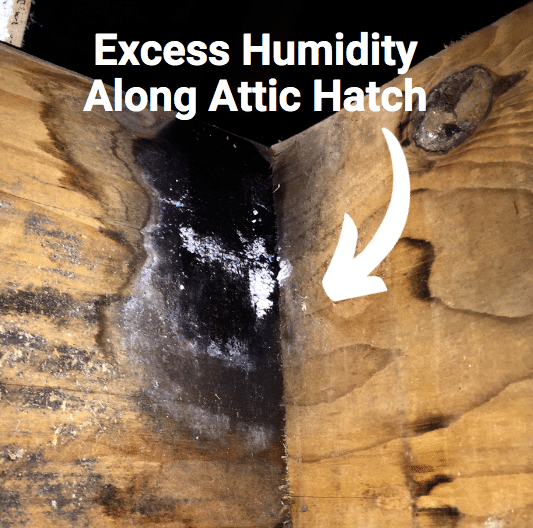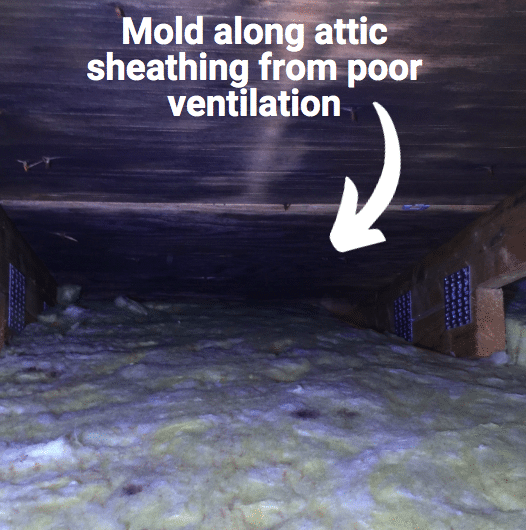Is There Mold Growing In My Attic?
Your attic is an unfinished space that contains insulation, vent ducts, the roof structure and sometimes storage items (not advised). With unfinished attics, people go in there when they need to investigate a problem such as a leak, pest problem, ventilation issue, or of course mold growth.
One of the most common areas of the home where mold grows is in the attic. There are several reasons for this.
Unfinished attics are cooler in the winter and warmer in the summer. Due to these extreme temperature changes, there are a number of opportunities for moisture to enter the attic.
Reasons For Attic Mold
Roof leaks and or blocked/missing ventilation can cause attic mold. Other condensation problems exist when warm moist air escapes into the attic through improper ventilation (bathroom or laundry) and voids from the ceiling below.
Roof leaks and or blocked/missing ventilation can cause attic mold. Other condensation problems exist when warm moist air escapes into the attic through improper ventilation (bathroom or laundry) and voids from the ceiling below.
Another contributing factor to mold in the attic is from bathroom exhaust fans venting out through the soffit.
The reason this is an issue is because the warm moist air cycles directly back into the attic through adjacent soffits along the eaves, causing condensation on the sheathing.
The photo shows heavy mold growth along the sheathing, which has accumulated over a number of years. This is likely the result of from inadequate/blocked ventilation or possibly condensation.


Improper slope and roof design also contributes to mold growth problems. When a roof slope is too low, the sheathing creates a nice plane for dust and mold spores to settle.
Ideally, the roof slope should be steep as it allows for better ventilation from the soffit below.
A minimal roof slope with poor air circulation prevents the needed air exchange for this space, allowing condensation along the lower sheathing to develop. When left unchecked, mold will begin to grow.
Notice the evidence of moisture along the frame below the attic hatch, which is another sign that too much humidity is seeping into the attic. This photo illustrates this issue.
The humidity issue in this case, is coming from inside the home and up into the attic.
The people who live there are generating too much humidity, without allowing the warm humid air to vent outside through kitchen or bathroom vents.
Is Attic Mold Growth A Problem?


Over time, mold growth causes damage, and may accelerate the ageing process of the roof, from below.
The attic mold may be wide spread, or isolated to certain areas of the roof sheathing. The amount of mold depends on how long it has been there.
OSB (Oriented Strand Board) type of sheathing is typically used in modern construction. Unfortunately this type of material is known to be excellent mold food.
Plywood was used in many older houses and townhouses. It is more robust, yet is still susceptible to mold growth when there is enough moisture.
Mold in the attic can be several colours, including white, green, brown and of course, black. The colour is not important, it helps identify actual mold growth.
This photo illustrates an example of black mold routinely seen on the roof sheathing during a mold inspection.
Is Attic Mold Harmful or Dangerous?

When the attic is completely sealed from the inside of the home, then it is not likely for attic mold to be a dangerous health hazard. However, when mold infected storage items are taken into the living space then yes, mold may cause health problems to those with mold allergies.
When mold migrates from one area of the home to another, this is known as cross-contamination. To avoid cross-contamination, you must ensure that all mold-infected items are properly contained prior to moving them. A remediation contractor should be called to assist you with this.
Does Mold Grow On Attic Insulation?

However, where there is organic debris on the insulation, such as dirt or dust, then yes it is possible for mold to grow on the insulation, especially when there is enough moisture present.
You will typically find this on either Fiberglass batt insulation or blown in Fiberglass insulation. This picture shows clear evidence of mold growing on the debris of pink, blown in insulation.
The Cost Of Attic Mold Removal
Attic mold removal or what is also known as attic mold remediation is not covered in detail within this chapter. However, people want and need to know how to deal with a mold crisis, and how much it will cost.
The cost of removing attic mold depends on a number of factors, including:
- A mold inspection to discover the source of the attic mold
- How much mold is growing and or how wide spread the attic mold problem is
- How difficult it will be to remove the attic mold
- How long it will take to complete the mold remediation job
- Which mold remediation company you choose
- Which method (s) or processes are used by the company
- The square footage of the attic space

Tip #1
You don’t want to put your home on the market only to discover that there is an undiscovered leak in your attic that could have been prevented, and you now need expensive repairs.
The picture reveals mold growing along the lower part of a separation wall, which originated from a roof leak between two townhouses.
Once discovered by the buyer’s home inspector, I was called in to investigate. This issue could have been prevented through a proactive mold inspection.
Tip #2
Tip #3
Nowadays the R-Value (resistance value) of attic insulation should be at least R50+. In addition, make sure insulation has been installed around skylights and fans because they are often missed.
All other voids leading to the attic will also need to be sealed, including vents, pot lights, plumbing stacks, or any other holes along the top ceiling of your home.
Tip #4
Tip #5
Tip #6
Tip #7
Improve attic ventilation. Soffit vents need airflow as well. So, if they are covered up, you will have to remove the insulation to allow for proper ventilation.
Baffles (rectangular Styrofoam channels) – designed to allow air movement from the soffit up through the attic) should be installed on the sheathing between the rafters. This allows for the needed air to circulate and escape.
Upper attic roof vents, such as roof or ridge vents should be installed to allow air from the soffits to escape.
When gable vents (vents along the sidewalls of the attic) have been installed, they should never compete with any other attic vents such as roof or upper ridge vents. For more clarification on this, speak to an attic ventilation contractor or roofer.
Tip #8
In the next chapter, we crawl into the crawlspace and examine how to prevent mold.
